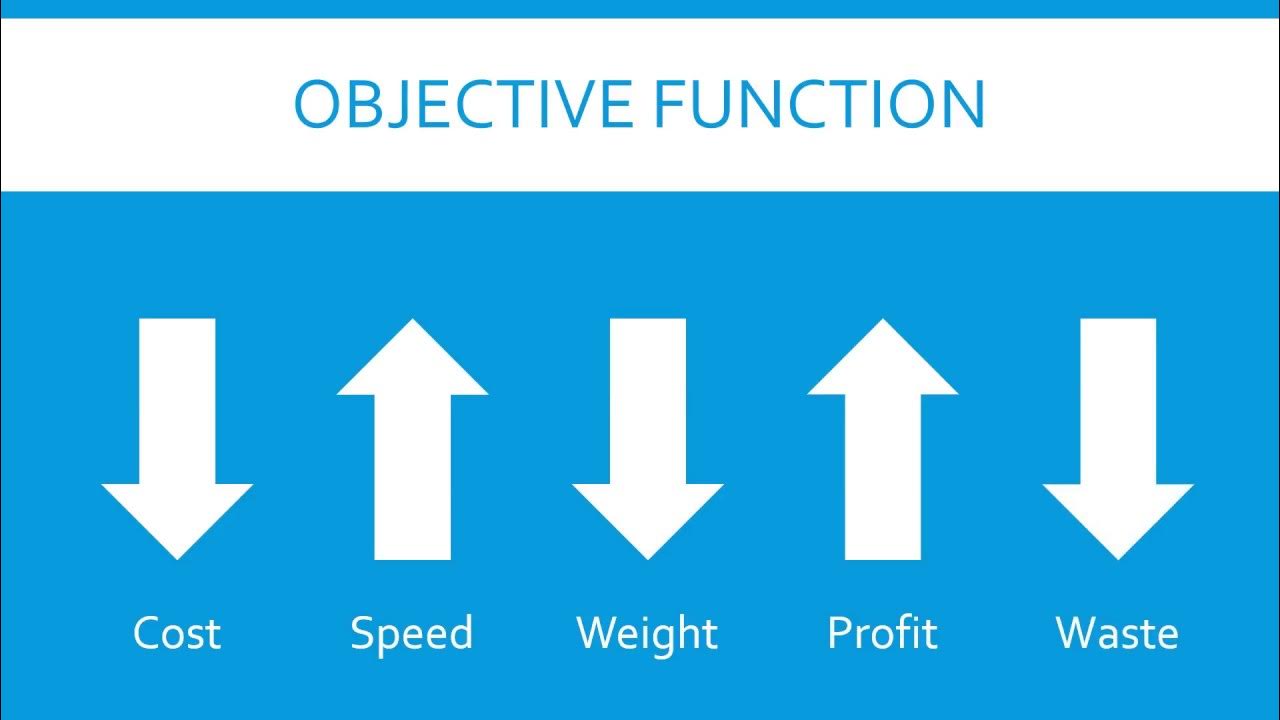Teknik Optimisasi
Summary
TLDRThis educational video covers optimization techniques in economics, particularly using calculus to analyze decision-making, cost functions, and maximizing profits. It explores methods like marginal cost, total quality management (TQM), benchmarking, re-engineering, and learning organizations. The video also discusses advanced optimization concepts such as multivariate calculus and the importance of differentiating between maximum and minimum points. Management tools like virtual integration and new process management techniques are also introduced, emphasizing continuous learning and adaptation for competitive advantage. The session concludes with a focus on the practical applications of these methods in real-world business scenarios.
Takeaways
- 😀 The script introduces the concept of optimization techniques in economics, particularly focusing on decision-making, using methods such as calculus and optimization without constraints.
- 😀 It explains the relationship between economic functions and optimization methods, which can be represented in equations, tables, or graphs. Example: Revenue function and its marginal revenue (MR).
- 😀 The script provides a detailed example of calculating and visualizing the revenue function and marginal revenue through equations, tables, and graphs to understand how they behave.
- 😀 The concept of cost functions is discussed, with an emphasis on average cost (AC) and marginal cost (MC). The script demonstrates how these costs are calculated and represented graphically.
- 😀 To optimize profit, two methods are outlined: analyzing the difference between total revenue and total costs, and using marginal analysis (MR = MC).
- 😀 It briefly revisits the rules of differentiation, showing how calculus principles apply to economics for optimization, particularly in business mathematics.
- 😀 First and second derivatives are discussed for optimization. The first derivative finds critical points, while the second derivative helps determine if those points represent maxima or minima.
- 😀 A specific example is given to show how optimization with calculus can identify a maximum revenue point, explaining the significance of first and second derivatives in this process.
- 😀 The script touches on multivariate optimization, explaining how to handle functions with more than one variable (e.g., profit function in terms of x and y) using partial derivatives.
- 😀 The script concludes by discussing modern management optimization tools, including benchmarking, total quality management (TQM), reengineering, and learning organizations, with examples of successful applications and challenges in these methods.
Q & A
What is the main purpose of using optimization techniques in economics?
-Optimization techniques are used to make decisions that maximize or minimize certain outcomes, such as profit or cost. In economics, these methods help in finding the best allocation of resources or maximizing business profitability.
How does marginal analysis help in decision-making for profit maximization?
-Marginal analysis involves comparing the marginal revenue (MR) with marginal cost (MC). Profit is maximized when MR equals MC, which helps businesses identify the optimal level of production or pricing.
What are the differences between optimization with constraints and unconstrained optimization?
-Unconstrained optimization seeks to find the optimal solution without restrictions, while optimization with constraints, such as Lagrange multipliers, involves finding the optimal solution under specific limitations or conditions.
What role does the first derivative play in optimization problems?
-The first derivative of a function helps identify critical points, which are points where the function may have a maximum or minimum value. Setting the first derivative equal to zero allows finding these critical points.
How does the second derivative test determine whether a critical point is a maximum or minimum?
-The second derivative test examines the concavity of the function at a critical point. If the second derivative is positive, the function has a local minimum. If it is negative, the function has a local maximum.
What is the significance of multivariate optimization in business decision-making?
-Multivariate optimization involves functions with multiple variables, allowing businesses to analyze complex situations where several factors influence the outcome. By using partial derivatives, businesses can optimize multiple interrelated variables simultaneously.
Can you explain how Lagrange multipliers are used in optimization problems?
-Lagrange multipliers are used to find the optimum of a function subject to constraints. By introducing an auxiliary variable (the multiplier), it helps incorporate the constraint into the optimization process, allowing for the determination of optimal solutions with limitations.
What are some real-world applications of optimization in economics and business?
-In economics and business, optimization methods are used to maximize profits, minimize costs, optimize production schedules, determine optimal pricing strategies, and allocate resources efficiently. They are applied in areas like manufacturing, marketing, and financial planning.
What are the core principles behind Total Quality Management (TQM)?
-TQM is a management approach focused on continuous improvement and customer satisfaction. It involves all employees in enhancing product quality and business processes, with a strong emphasis on meeting customer expectations and delivering consistent value.
How does benchmarking contribute to business optimization?
-Benchmarking involves comparing a company's processes and performance with best practices or industry leaders. It provides valuable insights on areas for improvement and helps businesses adopt more efficient strategies, leading to increased competitiveness and productivity.
Outlines

Этот раздел доступен только подписчикам платных тарифов. Пожалуйста, перейдите на платный тариф для доступа.
Перейти на платный тарифMindmap

Этот раздел доступен только подписчикам платных тарифов. Пожалуйста, перейдите на платный тариф для доступа.
Перейти на платный тарифKeywords

Этот раздел доступен только подписчикам платных тарифов. Пожалуйста, перейдите на платный тариф для доступа.
Перейти на платный тарифHighlights

Этот раздел доступен только подписчикам платных тарифов. Пожалуйста, перейдите на платный тариф для доступа.
Перейти на платный тарифTranscripts

Этот раздел доступен только подписчикам платных тарифов. Пожалуйста, перейдите на платный тариф для доступа.
Перейти на платный тарифПосмотреть больше похожих видео

Basics of Optimization Techniques #1 | GTU Learning #hindi

Chapter 1: 1 Introduction to Managerial Economics

Introduction To Optimization: Objective Functions and Decision Variables

1 Linear Programming - Concept17072020

| AKTU Digital Education| Managerial Economics |Fundamental Principles of Managerial Economics ....

Penerapan Ilmu Ekonomi dalam Kegiatan Usaha - Mapel Ekonomi Bisnis KD. 3.12
5.0 / 5 (0 votes)
